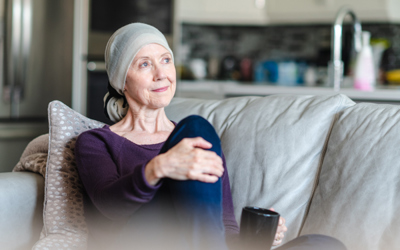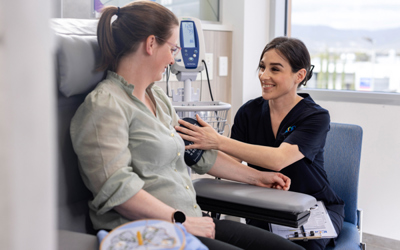What are the treatment options for ovarian cancer?
The primary treatment options for ovarian cancer include surgery, chemotherapy, hormone therapy and targeted therapies. The type of treatment you receive will depend on several considerations, such as the stage of your ovarian cancer, your medical history and your individual treatment preferences. This page aims to give you a comprehensive overview of how ovarian cancer treatment works.
Surgery for ovarian cancer
Surgery is often the first stage in treatment for ovarian cancer. During surgery, a biopsy will be taken to determine the type of ovarian cancer you have and whether further treatment will be required. Depending on the stage of your ovarian cancer, you will receive one of the below surgical procedures.
-
Laparoscopy
A laparoscopy, also known as keyhole surgery, is a procedure used for early ovarian cancer. It involves small incisions in the abdomen, which are used to insert a tube with a camera on it and surgically remove the cancerous tissue.
-
Laparotomy
A laparotomy may be required for more advanced ovarian cancers, which involves an incision from the pubic bone to the belly button to remove the affected tissue and organs. This may include removing the uterus, fallopian tubes and ovaries, which is known as a hysterectomy with bilateral salpingo-oophorectomy.
Hormone therapy for ovarian cancer
As hormones can be a source of fuel for ovarian cancer, hormone therapies can be used to block or lower your body’s natural hormones to stop hormone-sensitive cancers from growing or returning. For ovarian cancer, hormone therapy is mainly used to treat stromal tumours. Hormone therapy treatment is commonly given as a tablet or injection. In some cases, surgery may be used to remove the parts of the body that produce hormones.
Common hormone therapy medicines
For many women, hormone therapy is used in combination with chemotherapy or surgery and is delivered over five to ten years. These treatments typically fall under three categories:
-
Tamoxifen
Tamoxifen blocks oestrogen from communicating with your ovarian cancer cells. This is commonly taken by people who have not experienced menopause, when oestrogen is being created primarily in the ovaries.
-
Aromatase inhibitors
If your ovaries stop working due to menopause or other causes, your fat tissues will become the body’s main producer of oestrogen. Aromatase inhibitors stop this oestrogen from impacting your cancer’s growth and spread.
-
Luteinizing-hormone-releasing hormone (LHRH) agonists
Ovarian suppression targets oestrogen production in the ovaries, creating a temporary menopause.
Chemotherapy for ovarian cancer
Chemotherapy uses a range of drugs to destroy and slow the growth of ovarian cancer cells. The type of drug you receive will vary based on the type and stage of your ovarian cancer. These drugs may be delivered at any stage of your ovarian cancer treatment. Chemotherapy plays an important part in reducing the risk of your ovarian cancer returning, both locally and throughout the rest of the body.
Learn more about chemotherapy and how it is delivered.
Chemotherapy treatment takes place over several sessions, known as a cycle. Your care team will walk you through how many cycles you may need for your course of treatment, with most people completing chemotherapy in a period of three to six months.
Common chemotherapy medicines
There are several chemotherapy drugs that are used to treat ovarian cancer. These drugs are typically combined based on the stage of your ovarian cancer and if it has spread. Some of the drugs used include:
Taxanes – paclitaxel, docetaxel, abraxane
Anthracyclines – doxorubicin
Antimetabolites – gemcitabine, capecitabine
Targeted therapy for ovarian cancer
Targeted therapies use specialised drugs to destroy specific proteins in ovarian cancer cells, while leaving healthy cells intact. These drugs aim to stop ovarian cancer cells from repairing themselves when they get damaged.
Common targeted therapy medicines
Common targeted therapy drugs which are used to treat ovarian cancer include:
-
Bevacizumab
Bevacizumab is used to treat epithelial tumours and is delivered intravenously. This type of targeted therapy drug is given along with chemotherapy.
-
Olaparib
This is a less common drug which is most often used to treat high-grade epithelial ovarian cancer and advanced ovarian cancer that has a BRCA gene mutation. This type of targeted therapy drug is delivered orally.
-
Niraparib
This targeted therapy drug is used to treat advanced ovarian cancer with or without a BRCA mutation. It is given orally as a tablet once daily.
Clinical trials for ovarian cancer
Icon offers a wide range of clinical trials providing patients with access to new and evolving treatments. Clinical trials offer hope and opportunity and contribute to breakthroughs in treatment for future cancer patients.

Treatment by stage of ovarian cancer
When you are diagnosed with ovarian cancer, your oncologist will develop your treatment plan as part of a multidisciplinary team based on the stage of your cancer. Most treatment plans will begin with surgery to determine the cancer stage and to remove as much of the tumour(s) as possible. The tumour removal is often referred to as debulking. Following surgery, cycles of chemotherapy will be given. In cases of more advanced ovarian cancer, targeted therapies may be administered along with chemotherapy.
Stage I ovarian cancer
Surgery is the primary treatment for stage I ovarian cancer, which typically involves a hysterectomy with bilateral salpingo-oophorectomy. Stage IA and IB ovarian cancer may be further classified as grade 1, 2 or 3. Grade 1 tumours are considered low grade and you usually won’t require further treatment. However, Grade 2 and 3 tumours are considered high grade tumours and will typically be treated with chemotherapy as well. Treatment for stage IC ovarian cancer will commonly involve surgery and three to six cycles of chemotherapy.
Stage II ovarian cancer
Stage II ovarian cancer is treated similarly to high grade stage I ovarian cancer, beginning with surgery to remove any cancerous tissue. After surgery, your doctor will likely recommend at least six cycles of chemotherapy.
Stage III ovarian cancer
Stage III ovarian cancer treatment typically begins with surgery, including a radical hysterectomy with bilateral salpingo-oophorectomy. Depending on how far your cancer has spread, surrounding organs may also need to be removed, including parts of the intestine, bladder or liver. Following surgery, chemotherapy will be given for at least six cycles. Targeted therapy drugs may also be given alongside chemotherapy.
Stage IV ovarian cancer
Stage IV ovarian cancer is not considered curable in most cases, with treatment focusing on palliative care. This may include surgery to remove cancerous tissue, followed by chemotherapy and targeted therapies to relieve your symptoms.









